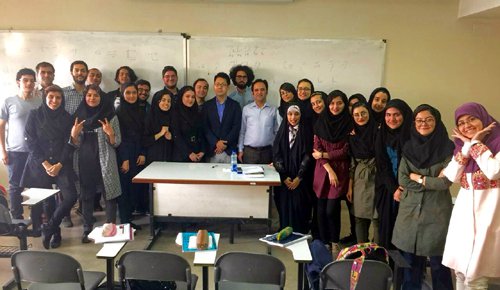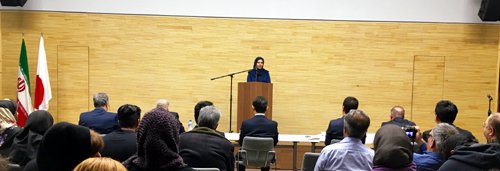Dispatch of Japanese-Language Specialists Resumes
University of Tehran
SUDO Nobuhiro
I’m a little at a loss at what to do, because if I start with the words, “I surrender my heart to the eternal winds of Persia,” someone is bound to say, “That’s not a blog about life overseas.”
Although not “eternal,” Japanese-language education in Iran has a long history. Starting off as a second foreign language course at the University of Tehran in 1989, by 1994 the university had established its own Japanese department, which was followed in 2008 by the establishment of a Japanese-language education major in the master’s degree course. Then, from 2012 the university started implementing the Japanese-Language Proficiency Test (hereinafter “JLPT”). A Japanese-Language Specialist has been dispatched to Iran from the Japan Foundation for the first time since 2009, resuming after a hiatus of eight years. My Iranian colleagues and I are currently spending our days exploring what we can and cannot do and what things we have and those that we do not.
I am affiliated to the Japanese Department of the Faculty of Foreign Languages and Literatures at the University of Tehran, and from this year the curriculum was revised following a change from a nine-semester system to an eight-semester system, and some of the teaching materials were also changed. As the number of semesters has been reduced, I am engaging in daily discussions with my colleagues about how we might avoid lowering the attainment targets for Japanese-language education.

Group photo with first-year students
JLPT is used as one of the benchmarks for undergraduate students to achieve by the time of graduation. Even when the test was not available in Iran it was also used as a reference and today it is possible to actually take the test to assess your skills (for better or worse). The test has never been compulsory and there are some students who don’t take it, but having an opportunity to measures one’s ability is very important for continued learning. Students continue their students in such an environment, with some also advancing to graduate school.
As noted above, a Japanese-language education major at the graduate school of the University of Tehran was established in 2008 and since then a number of outstanding students have graduated from the master’s degree course. Some of the graduates of this course have themselves become teachers at the university’s open Japanese course for the general public, contributing to the development of Japanese-language education in the region.
There are approximately 120 people studying Japanese in the open course. There are a variety of age groups and people have various motivations for learning, with some middle-aged to elderly people saying that they once used to live in Japan and would like to continue learning Japanese. Among the younger students, some are majoring in science or math, but would like to study in Japan someday, whereas others have a love of anime and manga. The abovementioned JLPT and the Iran Japanese Speech Contest offer opportunities for a diverse range of Japanese-language learners to participate and present their achievements.
In February 2018, the 20th Iran Japanese Speech Contest took place with a combined total of 15 learners in the beginners and advanced categories taking part. Most of the participants were individual learners, students on the open course, or Japanese majors at the University of Tehran. The venue at the Japanese embassy in Iran was filled with more than 100 audience members, many of whom were Iranian, demonstrating the level of interest in the contest.

Scene from the Japanese speech contest, where more than 100 people attended.
That Japanese-language education in Iran is gradually advancing in this way is due in large part to the efforts of everyone involved in Japanese-language education in the region. If more opportunities could be created for teachers to learn from each other, and if there is an expansion in the environments where Japanese can be studied beyond the University of Tehran, I believe that the Japanese-language education environment will develop further. A look at the “Country and Regional Information about Japanese-Language Education Abroad” shows that there are relatively few institutions providing Japanese-language education and similarly few learners in Iran.
In addition to the existing approaches, I think it is important to make connections both inside and outside the country. I regularly exchange opinions and share information on these matters with my colleagues at the University of Tehran and with the embassy’s public relations and cultural affairs staff.
The teachers at the University of Tehran are all very talented and ambitious, and it is perhaps for this reason that they also have a healthy concern about whether or not their teaching style is sufficient. For diplomatic reasons, it is difficult for Iran to participate in the Japanese-language education network in the Middle East, and the unstable internet environment also makes online training difficult. It is for this reason that as a first step, I launched a study group for teachers at the University of Tehran. We share information about the current situation in other countries and concerns or queries about classroom-based teaching. There is always a lively exchange of ideas.
Speaking of interactions, in Iran the short-messaging app “Telegram,” which is similar to LINE in Japan, is used on a daily basis on smartphones. On Telegram, there is a private channel about Japanese language and culture, which as of April 2018 has 3,000 subscribers. This is just one example that illustrates the considerable interest in Japan and Japanese. The owner of this channel is a graduate school student majoring in Japanese-language education at the University of Tehran, and I think it is also important to provide behind-the-scenes support to these independent and spontaneous activities by influencers.
In the six months that I have been here, various other events have taken place, including a performance of a Japanese-language play, exchange with Japanese students, a calligraphy workshop at the Japanese embassy, and the publication of a Japanese newsletter at the university. I hope to be able to introduce some of these on another occasion, or through a different medium.
Every day, I am thinking not just about Japanese language and culture, but also questioning more fundamental matters like what is the best way to go about teaching, which in itself is an act that has an influence on other people. I will leave the parts that are beyond my understanding to the eternal Persian winds, and continue to work hard to further develop Japanese-language education in Iran, and also ensure that people in Japan know more about what is happening here.
- What We Do Top
- Arts and Cultural Exchange [Culture]
- Japanese-Language Education Overseas [Language]
- Japanese-Language Education Overseas [Language] Top
- Learn Japanese-language
- Teach Japanese-language
- Take Japanese-Language Test
- Know about Japanese-language education abroad
- The Japanese-Language Institute, Urawa
- The Japanese-Language Institute, Kansai
- Japanese-Language Programs for Foreign Specified Skilled Worker Candidates
- Japanese Language Education for Japanese Children Resident Overseas and for the Descendants of Migrants
- Archives
- Japanese Studies and Global Partnerships [Dialogue]
- JF digital collection
- Other Programs / Programs to Commemorate Exchange Year
- Awards and Prizes
- Publications
